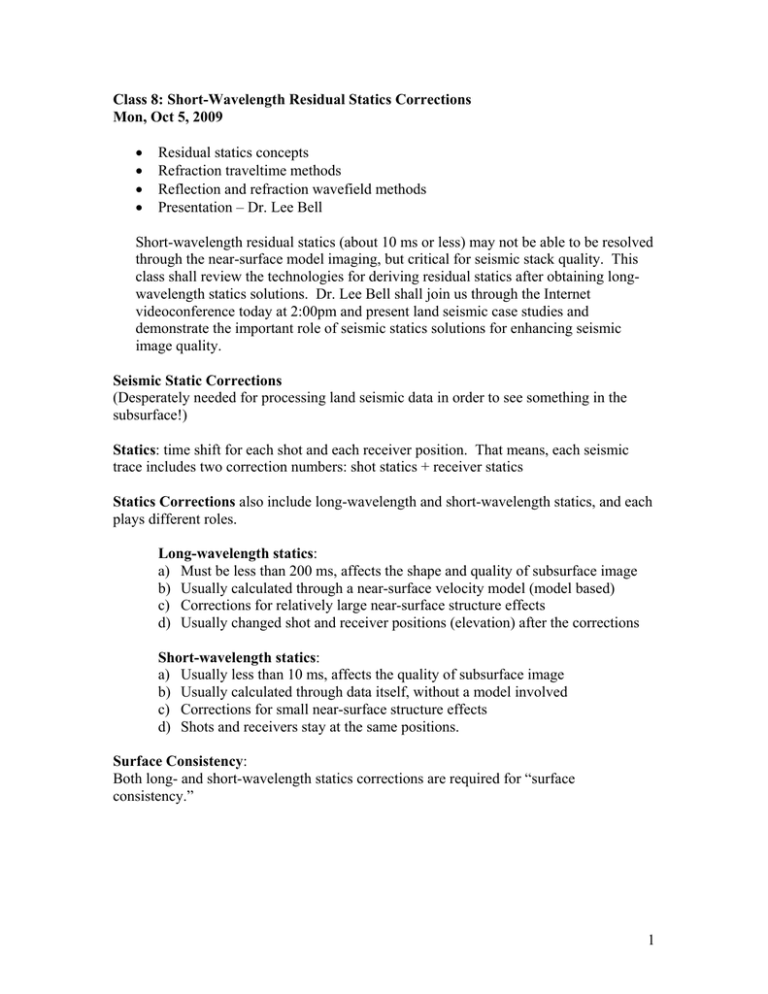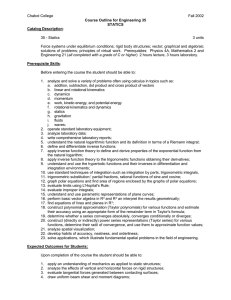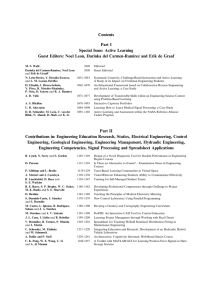Class 8: Short-Wavelength Residual Statics Corrections Mon, Oct 5, 2009
advertisement

Class 8: Short-Wavelength Residual Statics Corrections Mon, Oct 5, 2009 • • • • Residual statics concepts Refraction traveltime methods Reflection and refraction wavefield methods Presentation – Dr. Lee Bell Short-wavelength residual statics (about 10 ms or less) may not be able to be resolved through the near-surface model imaging, but critical for seismic stack quality. This class shall review the technologies for deriving residual statics after obtaining longwavelength statics solutions. Dr. Lee Bell shall join us through the Internet videoconference today at 2:00pm and present land seismic case studies and demonstrate the important role of seismic statics solutions for enhancing seismic image quality. Seismic Static Corrections (Desperately needed for processing land seismic data in order to see something in the subsurface!) Statics: time shift for each shot and each receiver position. That means, each seismic trace includes two correction numbers: shot statics + receiver statics Statics Corrections also include long-wavelength and short-wavelength statics, and each plays different roles. Long-wavelength statics: a) Must be less than 200 ms, affects the shape and quality of subsurface image b) Usually calculated through a near-surface velocity model (model based) c) Corrections for relatively large near-surface structure effects d) Usually changed shot and receiver positions (elevation) after the corrections Short-wavelength statics: a) Usually less than 10 ms, affects the quality of subsurface image b) Usually calculated through data itself, without a model involved c) Corrections for small near-surface structure effects d) Shots and receivers stay at the same positions. Surface Consistency: Both long- and short-wavelength statics corrections are required for “surface consistency.” 1 Questions: 1) Why long-wavelength statics is required to be less than 200 ms? 2) Why does long-wavelength statics calculation require down- and upgoing path and a replacement velocity? 3) In what situation that “surface consistency” fails? Long-wavelength statics solutions: Primarily involves resolving a near-surface velocity model by one of the following approaches: • • • • • • Refraction traveltime interpretation Refraction delay-time method Refraction traveltime and wavefield migration First-arrival traveltime tomography Early-arrival waveform tomography Dispersion-curve inversion Short-wavelength statics solutions: These are entirely data-based approaches: • • Refraction traveltime residual analysis Reflection or refraction stack-power maximization References: Ronen, J. and J. F. Claerbout, 1985: Surface-consistent residual statics estimation by stack-power maximization, Geophysics, Vol 50, 2759-2767. Hatherly, P., M. Urosevic, A. Lambourne, and B. J. Evans, 1994: A simple approach to calculating refraction statics corrections, Geophysics, Vol 59, 156-160. 2 Refraction traveltime method: Assumptions: same near-surface effects on both refraction and reflections 1) 2) 3) Given refraction traveltimes tij: ith source, jth receiver Apply long-wavelength statics to traveltimes: Tij : = tij + Δt Subtract by smoothed traveltimes, and the results: ΔTij Δtsi + Δtrj = ΔTij i=1, ns; j=1, nr Solve a set of linear equations iteratively 3 Reflection stack-power maximization method: 1) Conventional processing, CDP stack 2) Iterative process This image has been removed due to copyright restrictions. For every shot and every geophone: Iterative process: 1) 2) 3) 4) Form the super traces Crosscorrelate them Pick the maximum Correct the stack Questions: 1) With several hundreds of traces per shot, super trace is very long, any trick to save calculation time for crosscorrelation? 2) Why not correlate with trace by trace instead of supertrace? 4 MIT OpenCourseWare http://ocw.mit.edu 12.571 Near-Surface Geophysical Imaging� Fall 2009 For information about citing these materials or our Terms of Use, visit: http://ocw.mit.edu/terms.





